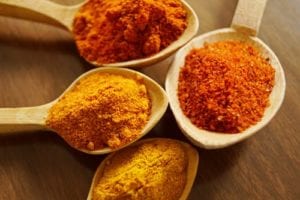Written by Taylor Woosley, Staff Writer. A meta-analysis of 66 RCTs showed that turmeric/curcumin supplementation significantly reduced levels of inflammatory markers including CRP (p < 0.001), TNF-α (p < 0.001), and IL-6 (p < 0.001), while also improving TAC levels (p < 0.001).
 When inflammation occurs in the body, it can regulate pathological and physiological signals of the body by affecting a variety of cells and factors, to promote the development of balance towards tissue repair and the elimination of inflammation1. However, excessive inflammation can cause uncontrolled production of inflammatory mediators such as cytokines, chemokines, and reactive oxygen species (ROS) which causes oxidative stress2. Cumulative oxidative damage to macromolecules, including DNA, proteins, and membrane lipids, affecting the health span of several organ systems3.
When inflammation occurs in the body, it can regulate pathological and physiological signals of the body by affecting a variety of cells and factors, to promote the development of balance towards tissue repair and the elimination of inflammation1. However, excessive inflammation can cause uncontrolled production of inflammatory mediators such as cytokines, chemokines, and reactive oxygen species (ROS) which causes oxidative stress2. Cumulative oxidative damage to macromolecules, including DNA, proteins, and membrane lipids, affecting the health span of several organ systems3.
Nutrition has long been recognized as an important determinant of inflammatory disease phenotypes and treatment response4. Curcumin, a polyphenolic yellow pigment in turmeric, interacts with cell molecular targets to upregulate tumor-suppressor genes and inhibit inflammatory signaling pathways5. Furthermore, curcumin mitigates oxidative stress and apoptosis by diminishing reactive oxygen species (ROS) levels and curbing the mitochondrial pathway6.
Dehzad et al. conducted a systemic review and meta-analysis to investigate the impact of turmeric/curcumin supplementation on markers of inflammation and oxidative stress. Inclusion criteria consisted of participants aged >18 years old, with a curcumin/turmeric supplementation intervention group of >2 weeks, with a matched control group for comparison. Additionally, the studies had to assess inflammatory markers (C-reactive protein (CRP), tumor necrosis factor (TNF-α), interleukin-6 (IL-6), interleukin 1 beta (IL-1β), total antioxidant capacity (TAC), malondialdehyde (MDA), superoxide dismutase (SOD)) before and after the study, using a randomized controlled trial (RCT) study design. To assess the risk of bias, the Cochrane quality assessment tool was utilized. Effect sizes were calculated using mean change and standard deviations for CRP, TNF-α, IL-6, IL-1β, TAC, MDA, and SOD in the intervention and placebo groups. Between-study heterogeneity was verified by the I2 statistic and Cochrane’s Q test.
A total of 66 RCTs were included in the final analysis. 8 studies were performed solely on female subjects and six studies on male subjects. The number of participants in the RCT samples ranged from 14 to 246, with a total sample size of 3953 individuals. The mean age of participants was between 18 to 70 years. The dosage of curcumin supplementation ranged from 80 mg/day (nano-curcumin) and 3000 mg/day (turmeric powder), and the duration of intervention ranged from 4 to 24 weeks. Significant findings of the study are as follows:
- The effect of curcumin/turmeric supplementation on CRP was examined in 52 arms of clinical trials shows that it significantly reduced CRP levels (WMD: -0.58 mg/l, 95% CI: -0.74, -0.41; p < 0.001), with significant between-study heterogeneity (I2 = 98.9%, p < 0.001).
- Combining 26 effect sizes via the random-effects model showed that curcumin/turmeric consumption can significantly reduce TNF-α (WMD: -3.48 pg/ml, 95% CI: -4.38, -2.58, p < 0.001). However, there was a high between-study heterogeneity (I2 = 99.4%, p < 0.001).
- Curcumin/turmeric supplementation significantly reduced IL-6 levels when effect sizes were pooled using 22 arms of trial (WMD: -1.31 pg/ml, 95% CI: -1.58, -0.67, p < 0.001), with significant between-study heterogeneity (I2 = 88.2%, p < 0.001).
- Meta-analysis of 19 arms of RCTs showed that curcumin/turmeric supplementation significantly increased TAC (WMD = 0.21 nmol/l; 95% CI: 0.08, 0.33, p = 0.001), with significant heterogeneity between studies (I2 = 99.6%, p < 0.001).
Results of the study suggest that turmeric/curcumin supplementation positively impacts markers of systemic inflammation and oxidative stress in subjects. Furthermore, neither dosage nor study duration of the turmeric/curcumin intervention exerted any impact on inflammatory/oxidative status of participants, except for TAC which showed a marginal significant association with the dosage of the intervention. Study limitations include
Source: Dehzad, Mohammad Jafar, Hamid Ghalandari, Mehran Nouri, and Moein Askarpour. “Antioxidant and anti-inflammatory effects of curcumin/turmeric supplementation in adults: A GRADE-assessed systematic review and dose–response meta-analysis of randomized controlled trials.” Cytokine 164 (2023): 156144.
© 2023 Elsevier Ltd. All rights reserved.
Click here to read the full text study.
Posted May 8, 2023.
Taylor Woosley studied biology at Purdue University before becoming a 2016 graduate of Columbia College Chicago with a major in Writing. She currently resides in Glen Ellyn, IL.
References:
- Li G, Ding K, Qiao Y, et al. Flavonoids Regulate Inflammation and Oxidative Stress in Cancer. Molecules. Nov 30 2020;25(23)doi:10.3390/molecules25235628
- Sul OJ, Ra SW. Quercetin Prevents LPS-Induced Oxidative Stress and Inflammation by Modulating NOX2/ROS/NF-kB in Lung Epithelial Cells. Molecules. Nov 17 2021;26(22)doi:10.3390/molecules26226949
- Tan BL, Norhaizan ME. Effect of High-Fat Diets on Oxidative Stress, Cellular Inflammatory Response and Cognitive Function. Nutrients. Oct 25 2019;11(11)doi:10.3390/nu11112579
- Demetrowitsch TJ, Schlicht K, Knappe C, et al. Precision Nutrition in Chronic Inflammation. Frontiers in immunology. 2020;11:587895. doi:10.3389/fimmu.2020.587895
- Blanton C, Gordon B. Effect of Morning vs. Evening Turmeric Consumption on Urine Oxidative Stress Biomarkers in Obese, Middle-Aged Adults: A Feasibility Study. Int J Environ Res Public Health. Jun 8 2020;17(11)doi:10.3390/ijerph17114088
- Chen Q, Tang Y, Deng H, et al. Curcumin Improves Keratinocyte Proliferation, Inflammation, and Oxidative Stress through Mediating the SPAG5/FOXM1 Axis in an In Vitro Model of Actinic Dermatitis by Ultraviolet. Dis Markers. 2022;2022:5085183. doi:10.1155/2022/5085183
